Stefanica D. A Primer for the Mathematics of Financial Engineering
Подождите немного. Документ загружается.

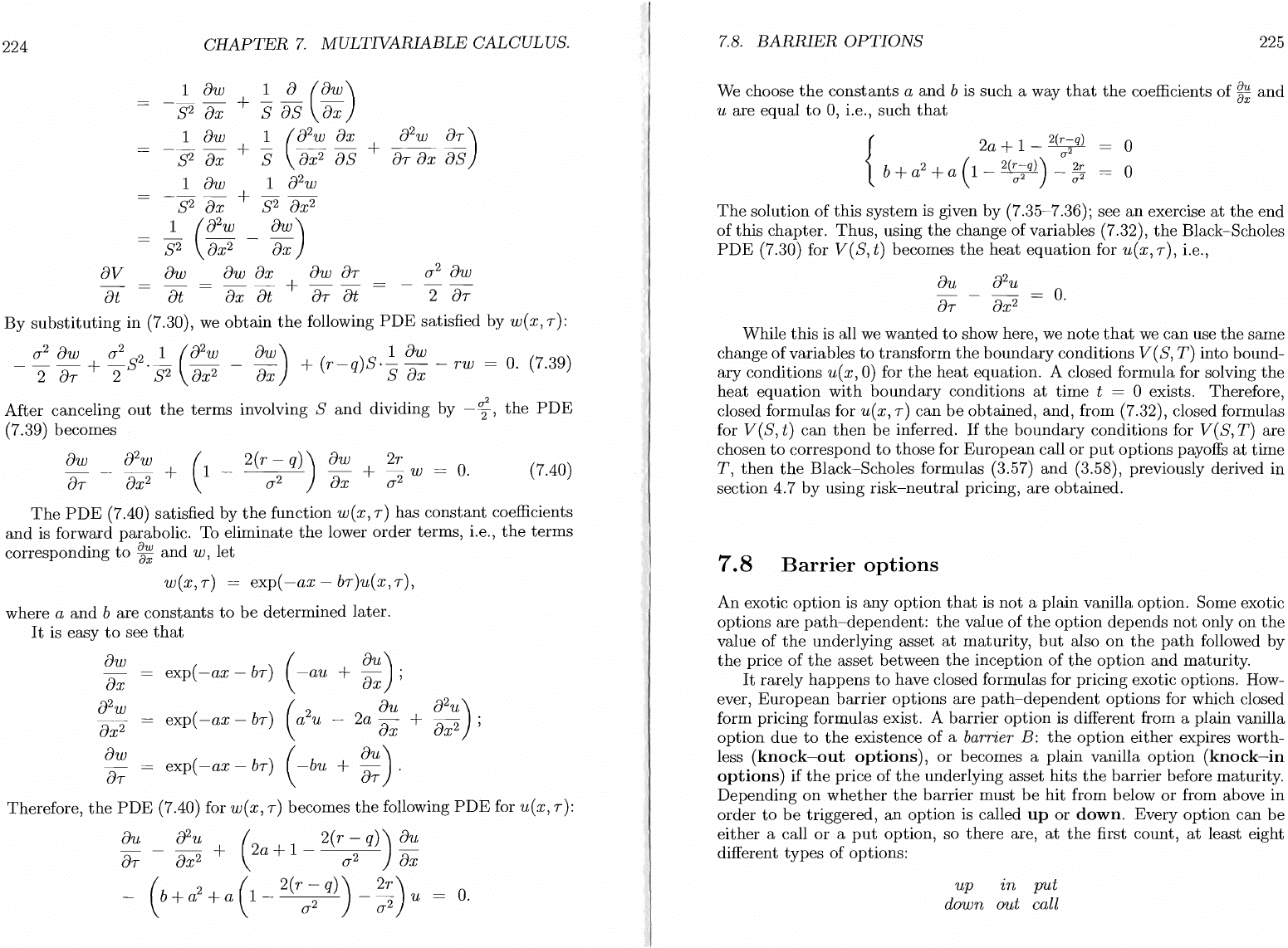
224
CHAPTER
7.
MULTIVARIABLE
CALCULUS.
oV
ot
1
ow
(J"2
ow
2
OT
By
substituting
in (7.30), we
obtain
the
following
PDE
satisfied by
w(x,
T):
(J"2
ow
(J"2
2 1
(02W
ow)
1
ow
- 2
OT
+ 2
S
.
S2
ox2 -
ox
+
(r-q)S·s
ox
-
rw
=
O.
(7.39)
After
canceling
out
the
terms
involving S
and
dividing by -
~2,
the
PDE
(7.39) becomes
2
(r
-
q))
ow
2r
_ 0
2
~
+
2W-.
(J" uX (J"
(7.40)
The
PDE
(7.40) satisfied by
the
function
w(x,
T)
has
constant
coefficients
and
is forward parabolic. To eliminate
the
lower order terms, i.e.,
the
terms
corresponding
to
~~
and
w, let
w(x,
T)
= exp(
-ax
- bT)U(X, T),
where a
and
b are
constants
to
be
determined later.
It
is easy
to
see
that
ow
exp(
-ax
-
bT)
oX
(-au
8U)
+
ox
;
02w
exp(
-ax
-
bT)
( a
2
u
ox
2
ou
2a-
ox
+
ow
exp(
-ax
-
bT)
(-bU
+
~~).
OT
8
2
u)
ox
2
'
Therefore,
the
PDE
(7.40) for
w(x,
T)
becomes
the
following
PDE
for
u(x,
T):
ou
02U
(
2(r
-
q))
ou
~
-
~
2 + 2a + 1 - 2
~
uT uX (J" uX
- (
b+
a
2
+ a ( 1 - 2 (r
<T~
q))
-
!:)
U
O.
7.B.
BARRIER
OPTIONS
225
We choose
the
constants
a
and
b is such a way
that
the
coefficients of
~~
and
u are equal
to
0, i.e., such
that
{
2a + 1 - 2(r-;-q) = 0
b + a
2
+ a
(1
- 2(r-
q
))
:.
2r
= 0
0-
2
0-
2
The
solution of
this
system
is given
by
(7.35-7.36); see
an
exercise
at
the
end
of this chapter.
Thus,
using
the
change of variables (7.32),
the
Black-Scholes
PDE
(7.30) for V(S, t) becomes
the
heat
equation
for
u(x,
T),
i.e.,
ou
02u
OT
- ox2 =
O.
While
this
is all we
wanted
to
show here, we
note
that
we can use
the
same
change
of
variables
to
transform
the
boundary
conditions V(S,
T)
into bound-
ary
conditions
u(x,
0) for
the
heat
equation. A closed formula for solving
the
heat
equation
with
boundary
conditions
at
time
t = 0 exists. Therefore,
closed formulas for
u(x,
T)
can
be
obtained, and, from (7.32), closed formulas
for
V(S, t)
can
then
be
inferred.
If
the
boundary
conditions for V(S,
T)
are
chosen
to
correspond
to
those for
European
call or
put
options payoffs
at
time
T,
then
the
Black-Scholes formulas (3.57)
and
(3.58), previously derived in
section 4.7
by
using
risk-neutral
pricing, are obtained.
7.8
Barrier
options
An
exotic
option
is
any
option
that
is
not
a plain vanilla option. Some exotic
options
are
path-dependent:
the
value of
the
option
depends
not
only on
the
value of
the
underlying asset
at
maturity,
but
also
on
the
path
followed by
the
price
of
the
asset between
the
inception of
the
option
and
maturity.
It
rarely
happens
to
have closed formulas for pricing exotic options. How-
ever,
European
barrier
options are
path-dependent
options for which closed
form pricing formulas exist. A barrier
option
is different from a plain vanilla
option
due
to
the
existence
of
a barrier B:
the
option
either
expires worth-
less
(knock-out
options),
or
becomes a plain vanilla
option
(knock-in
options)
if
the
price of
the
underlying asset
hits
the
barrier
before maturity.
Depending
on
whether
the
barrier
must
be
hit
from below
or
from above
in
order
to
be
triggered,
an
option
is called
up
or
down.
Every option can be
either a call
or
a
put
option, so
there
are,
at
the
first count,
at
least eight
different
types
of options:
up
in
put
down out call
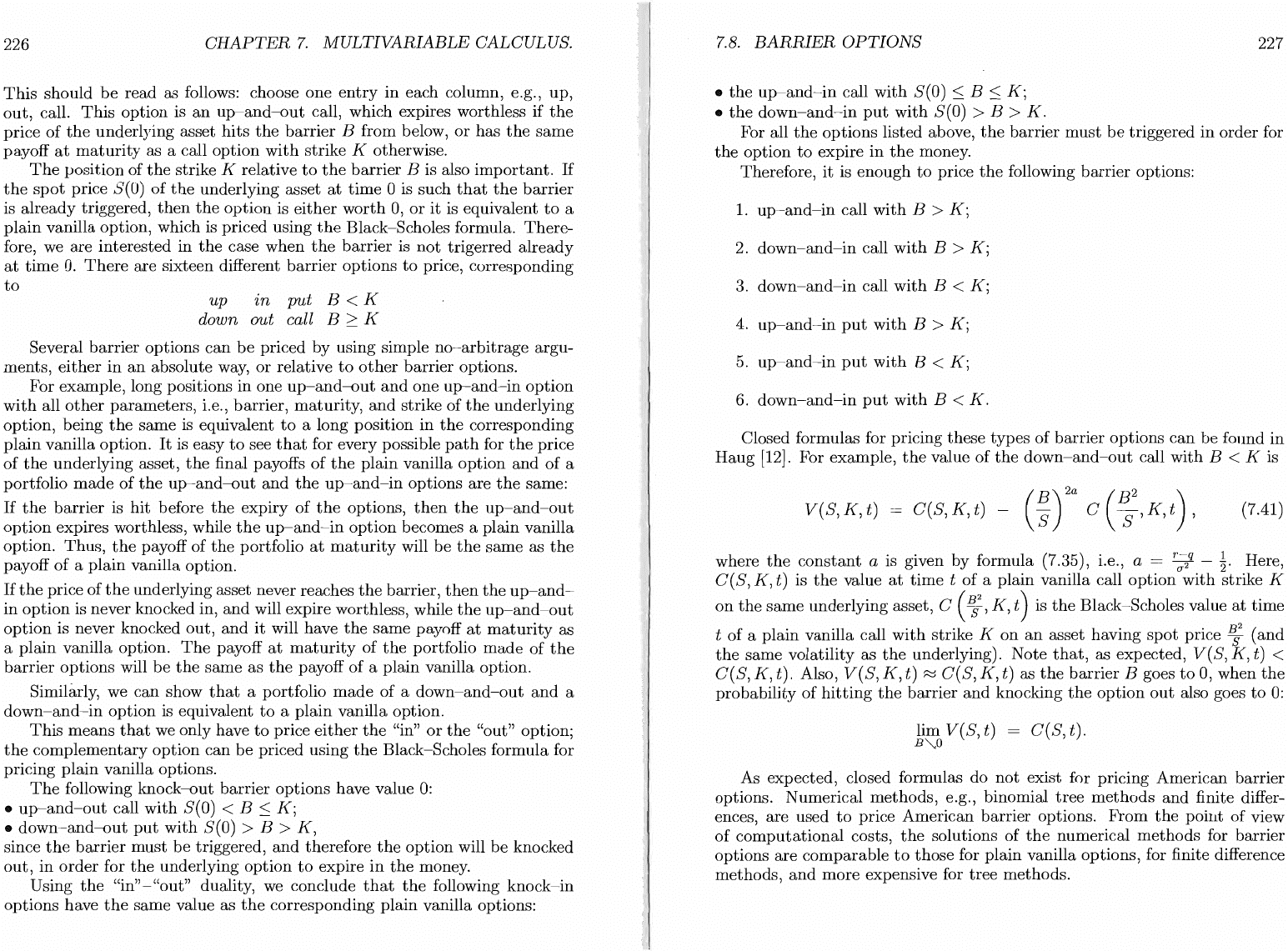
226
CHAPTER
7.
MULTIVARIABLE
CALCULUS.
This
should
be
read
as follows: choose
one
entry
in
each column, e.g.,
up,
out,
call.
This
option
is
an
up-and-out
call, which expires worthless
if
the
price
of
the
underlying asset
hits
the
barrier
B from below,
or
has
the
same
payoff
at
maturity
as a call
option
with
strike K otherwise.
The
position
of
the
strike K relative
to
the
barrier
B is also
important.
If
the
spot
price
8(0)
of
the
underlying asset
at
time
0 is such
that
the
barrier
is
already
triggered,
then
the
option
is
either
worth
0,
or
it
is equivalent
to
a
plain
vanilla option, which is priced using
the
Black-Scholes formula.
There-
fore, we
are
interested
in
the
case
when
the
barrier
is
not
trigerred
already
at
time
O.
There
are
sixteen different
barrier
options
to
price, corresponding
to
up
in
put
B < K
down out call B
~
K
Several
barrier
options
can
be
priced
by
using simple
no-arbitrage
argu-
ments,
either
in
an
absolute way,
or
relative
to
other
barrier
options.
For example, long positions
in
one
up-and-out
and
one up--and-in
option
with
all
other
parameters,
i.e.,
barrier,
maturity,
and
strike of
the
underlying
option,
being
the
same
is equivalent
to
a long position
in
the
corresponding
plain
vanilla option.
It
is easy
to
see
that
for every possible
path
for
the
price
of
the
underlying asset,
the
final payoffs
of
the
plain vanilla
option
and
of
a
portfolio
made
of
the
up-and-out
and
the
up-and-in
options
are
the
same:
If
the
barrier
is
hit
before
the
expiry
of
the
options,
then
the
up-and-out
option
expires worthless, while
the
up-and-in
option
becomes a plain vanilla
option.
Thus,
the
payoff of
the
portfolio
at
maturity
will
be
the
same
as
the
payoff
of
a
plain
vanilla option.
If
the
price
of
the
underlying asset never reaches
the
barrier,
then
the
up-and-
in
option
is never knocked in,
and
will expire worthless, while
the
up-and-out
option
is never knocked
out,
and
it
will have
the
same
payoff
at
maturity
as
a
plain
vanilla option.
The
payoff
at
maturity
of
the
portfolio
made
of
the
barrier
options
will
be
the
same
as
the
payoff
of
a plain vanilla option.
Similarly, we
can
show
that
a portfolio
made
of
a
down-and-out
and
a
down-and-in
option
is equivalent
to
a
plain
vanilla option.
This
means
that
we only have
to
price
either
the
"in"
or
the
"out" option;
the
complementary
option
can
be
priced using
the
Black-Scholes formula for
pricing
plain
vanilla options.
The
following
knock-out
barrier
options
have value
0:
•
up-and-out
call
with
8(0)
< B
:s:
K;
•
down-and-out
put
with
8(0)
> B >
K,
since
the
barrier
must
be
triggered,
and
therefore
the
option
will
be
knocked
out,
in
order
for
the
underlying
option
to
expire
in
the
money.
Using
the
"in"-"out"
duality, we conclude
that
the
following
knock-in
options
have
the
same
value as
the
corresponding plain vanilla options:
7.S.
BARRIER
OPTIONS
227
•
the
up-and-in
call
with
8(0)
:s:
B
:s:
K;
•
the
down-and-in
put
with
8(0)
> B >
K.
For all
the
options
listed above,
the
barrier
must
be
triggered
in
order
for
the
option
to
expire
in
the
money.
Therefore,
it
is
enough
to
price
the
following
barrier
options:
1.
up-and-in
call
with
B >
K;
2.
down-and-in
call
with
B >
K;
3.
down-and-in
call
with
B <
K;
4.
up-and-in
put
with
B >
K;
5.
up-and-in
put
with
B <
K;
6.
down-and-in
put
with
B <
K.
Closed formulas for pricing
these
types
of
barrier
options
can
be found
in
Haug
[12].
For example,
the
value
of
the
down-and-out
call
with
B < K is
V(8,K,t)
(
B)2a
(B2
)
C(8,K,t)
- 8 C
S,K,t
,
(7.41)
where
the
constant
a is given
by
formula (7.35), i.e., a =
r~q
-~.
Here,
C(8, K, t) is
the
value
at
time
t
of
a plain vanilla call
option
with
strike K
on
the
same
underlying
asset, C (
~2
,
K,
t)
is
the
Black-Scholes value
at
time
t
of
a
plain
vanilla call
with
strike K
on
an
asset having
spot
price
~
(and
the
same
volatility as
the
underlying).
Note
that,
as expected, V(8, K, t) <
C(8,K,t).
Also,
V(8,K,t)
~
C(8,K,t)
as
the
barrier
B goes
to
0, when
the
probability
of
hitting
the
barrier
and
knocking
the
option
out
also goes
to
0:
lim V(8, t) = C(8, t).
B"'.O
As expected, closed formulas do
not
exist for pricing American barrier
options. Numerical
methods,
e.g., binomial
tree
methods
and
finite differ-
ences,
are
used
to
price American
barrier
options.
From
the
point of view
of
computational
costs,
the
solutions
of
the
numerical
methods
for
barrier
options
are
comparable
to
those
for plain vanilla options, for finite difference
methods,
and
more
expensive for
tree
methods.
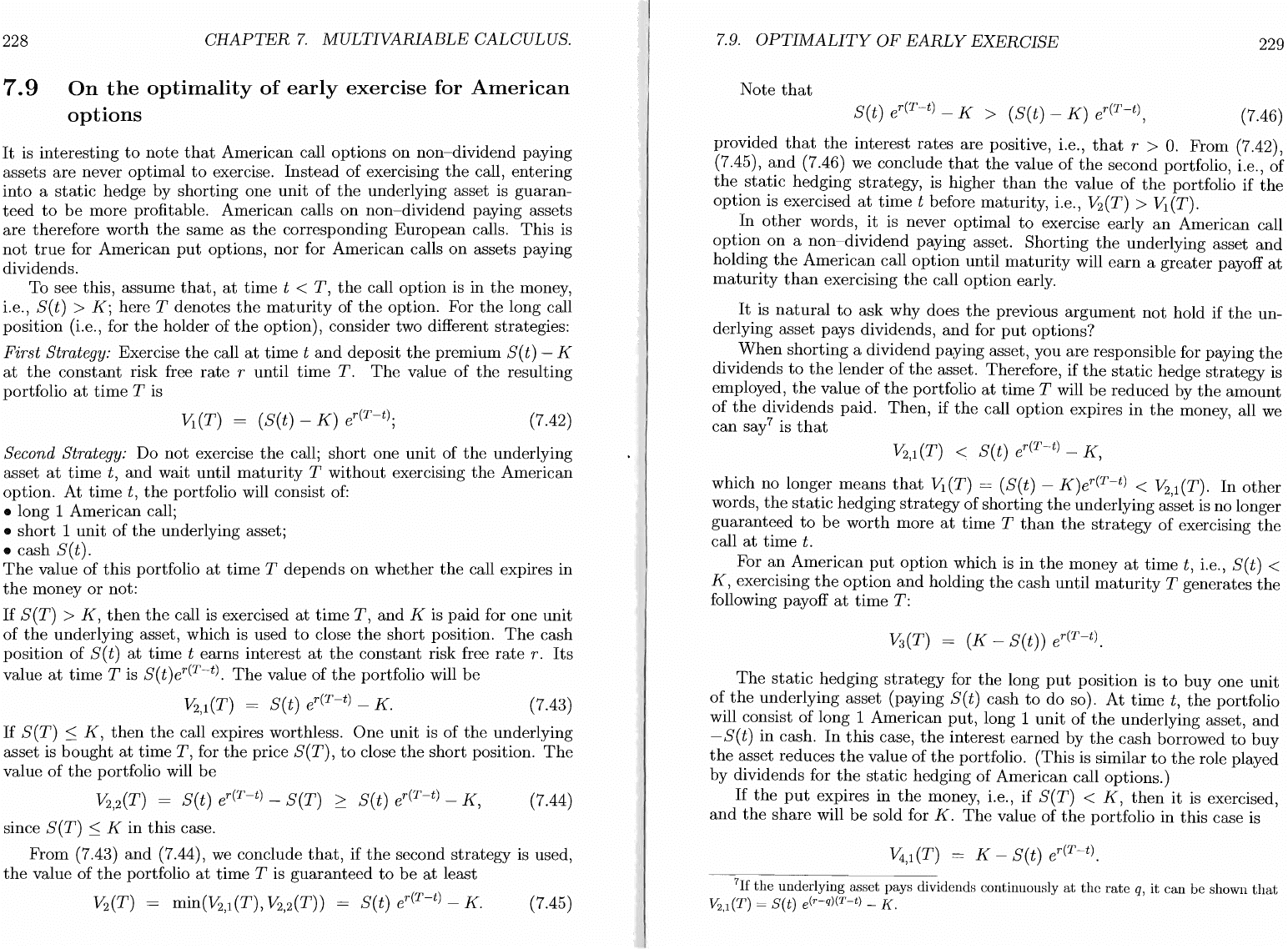
228
7.9
CHAPTER
7.
MULTIVARIABLE
CALCULUS.
On
the
optimality
of
early
exercise
for
American
options
It
is
interesting
to
note
that
American
call
options
on
non-dividend
paying
assets
are
never
optimal
to
exercise.
Instead
of
exercising
the
call,
entering
into
a
static
hedge
by
shorting one
unit
of
the
underlying asset is
guaran-
teed
to
be
more
profitable.
American
calls
on
non-dividend
paying assets
are
therefore
worth
the
same
as
the
corresponding
European
calls.
This
is
not
true
for American
put
options,
nor
for American calls
on
assets paying
dividends.
To see this, assume
that,
at
time
t <
T,
the
call
option
is in
the
money,
i.e., S(t) > K; here T denotes
the
maturity
of
~he
option
..
For
the
long
~all
position
(i.e., for
the
holder of
the
option), consIder two dIfferent strategIes:
First Strategy: Exercise
the
call
at
time
t
and
deposit
the
premium
S(t) - K
at
the
constant
risk free
rate
r
until
time
T.
The
value
of
the
resulting
portfolio
at
time
T is
Vt(T) = (S(t) -
K)
er(T-t);
(7.42)
Second Strategy: Do
not
exercise
the
call;
short
one
unit
of
the
underlying
asset
at
time
t,
and
wait until
maturity
T
without
exercising
the
American
option.
At
time
t,
the
portfolio will consist
of:
• long 1 American call;
•
short
1
unit
of
the
underlying asset;
•
cash
S(t). . .
The
value
of
this
portfolio
at
time
T
depends
on
whether
the
call expIres
III
the
money
or
not:
If
S(T)
>
K,
then
the
call is exercised
at
time
T,
and
K is
p~~d
for one
unit
of
the
underlying asset, which is used
to
close
the
short
posItIOn.
The
cash
position
of
S
(t)
at
time
t
earns
interest
at
the
constant
risk free
rate
r.
Its
value
at
time
Tis
S(t)er(T-t).
The
value
of
the
portfolio will
be
112,1
(T) = S( t)
er(T-t)
- K.
(7.43)
If
S(T)
::;
K,
then
the
call expires worthless.
One
unit
is
of
the
~~derlying
asset is
bought
at
time
T, for
the
price S(T),
to
close
the
short
posItIOn.
The
value
of
the
portfolio will
be
V2,2(T)
= S(t)
er(T-t)
-
S(T)
~
S(t)
er(T-t)
- K,
(7.44)
since
S(T)
::;
K
in
this
case.
From
(7.43)
and
(7.44), we conclude
that,
if
the
second
strategy
is used,
the
value of
the
portfolio
at
time
T is
guaranteed
to
be
at
least
V2(T)
= min(V2,1(T),V2,2(T)) = S(t)
er(T-t)
- K.
(7.45)
7.9.
OPTIMALITY
OF
EARLY
EXERCISE
229
Note
that
S(t)
er(T-t)
- K > (S(t) -
K)
er(T-t)
,
(7.46)
provided
that
the
interest
rates
are
positive, i.e.,
that
r >
O.
From
(7.42),
(7.45),
and
(7.46) we conclude
that
the
value
of
the
second portfolio, i.e.,
of
the
static
hedging strategy, is higher
than
the
value
of
the
portfolio if
the
option
is exercised
at
time
t before maturity, i.e.,
V2(T)
> Vt(T).
In
other
words,
it
is never
optimal
to
exercise
early
an
American call
option
on
a
non-dividend
paying asset.
Shorting
the
underlying asset
and
holding
the
American
call
option
until
maturity
will
earn
a
greater
payoff
at
maturity
than
exercising
the
call
option
early.
It
is
natural
to
ask
why does
the
previous
argument
not
hold if
the
un-
derlying asset pays dividends,
and
for
put
options?
When
shorting
a dividend paying asset, you
are
responsible for paying
the
dividends
to
the
lender
of
the
asset. Therefore, if
the
static
hedge
strategy
is
employed,
the
value
of
the
portfolio
at
time
T will
be
reduced
by
the
amount
of
the
dividends paid.
Then,
if
the
call
option
expires
in
the
money, all we
can
say7 is
that
V2,1(T)
< S(t)
er(T-t)
- K,
which no longer
means
that
Vt(T) = (S(t) - K)er(T-t) <
112,1
(T).
In
other
words,
the
static
hedging
strategy
of
shorting
the
underlying asset is no longer
guaranteed
to
be
worth
more
at
time
T
than
the
strategy
of
exercising
the
call
at
time
t.
For
an
American
put
option
which is
in
the
money
at
time
t, i.e., S(t) <
K,
exercising
the
option
and
holding
the
cash
until
maturity
T generates
the
following payoff
at
time
T:
~(T)
=
(K
- S(t))
er(T-t).
The
static
hedging
strategy
for
the
long
put
position is
to
buy
one
unit
of
the
underlying
asset (paying S(t) cash
to
do so).
At
time
t,
the
portfolio
will consist
of
long 1 American
put,
long 1
unit
of
the
underlying asset,
and
- S ( t)
in
cash.
In
this
case,
the
interest
earned
by
the
cash
borrowed
to
buy
the
asset reduces
the
value
of
the
portfolio.
(This
is similar
to
the
role played
by
dividends for
the
static
hedging
of
American call options.)
If
the
put
expires
in
the
money, i.e., if
S(T)
<
K,
then
it
is exercised,
and
the
share
will
be
sold for
K.
The
value
of
the
portfolio
in
this
case is
7If
the
underlying asset pays dividends continuously
at
the
rate
q,
it
can
be
shown
that
V2,l(T) = S(t)
e(r-q)(T-t)
- K.
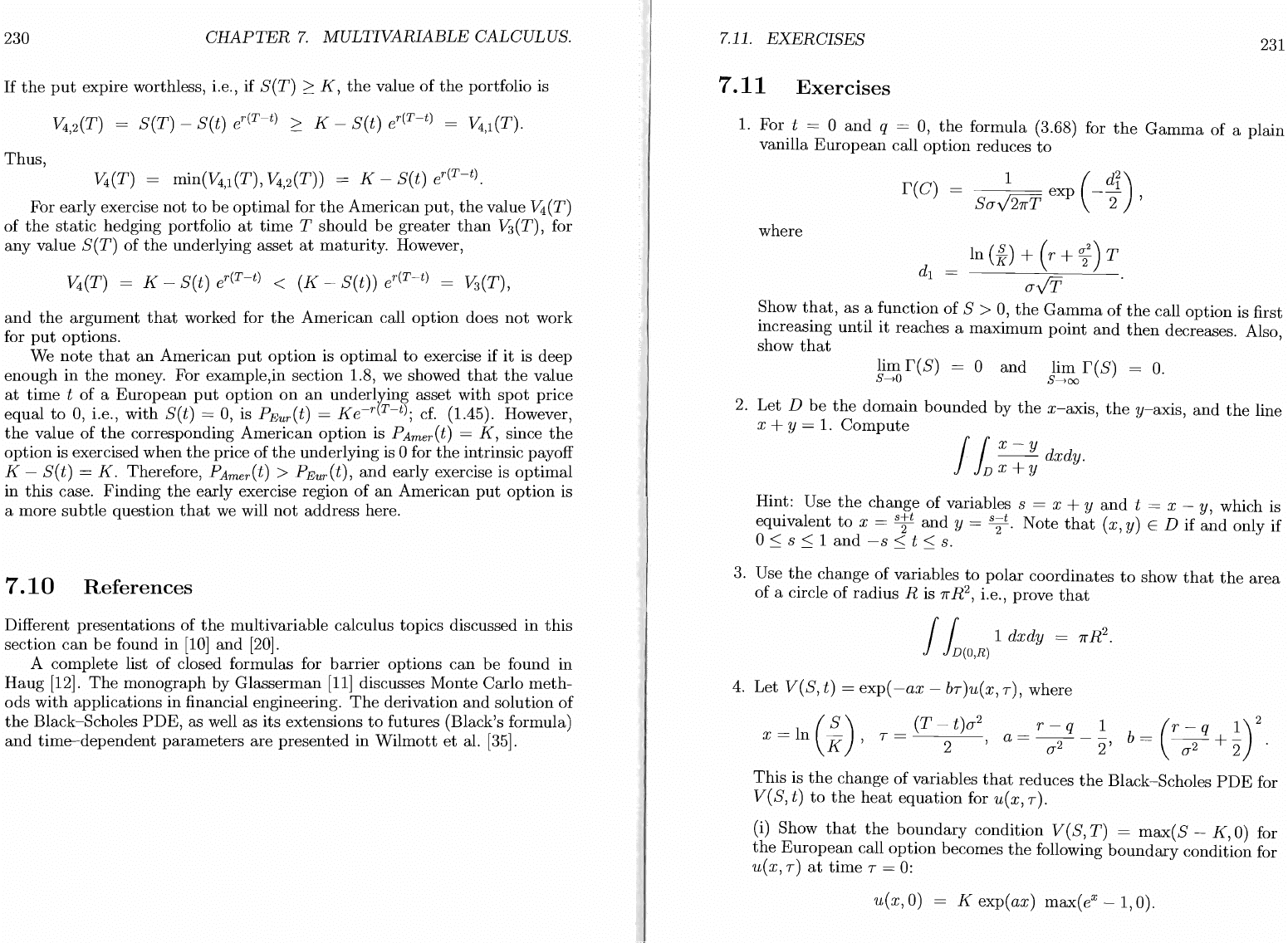
230
CHAPTER
7.
MULTIVARIABLE
CALCULUS.
If
the
put
expire worthless, i.e., if S(T)
;::::
K,
the
value
of
the
portfolio is
V4,2(T)
= S(T) - S(t)
er(T-t)
;::::
K - S(t)
er(T-t)
= V4,l(T).
Thus,
V4(T)
= min(V4,l(T),
Y4,2(T))
= K - S(t)
er(T-t).
For early exercise
not
to
be
optimal
for
the
American
put,
the
value
V4(T)
of
the
static
hedging portfolio
at
time
T should
be
greater
than
1I3(T)
, for
any
value S(T) of
the
underlying asset
at
maturity. However,
V4(T)
= K - S(t)
er(T-t)
<
(K
- S(t))
er(T-t)
=
1I3(T)
,
and
the
argument
that
worked for
the
American call
option
does
not
work
for
put
options.
We
note
that
an
American
put
option
is
optimal
to
exercise if
it
is deep
enough
in
the
money. For example,in section 1.8, we showed
that
the
value
at
time
t
of.
a Eu::opean
put
o~tion
on
an
und~;~~f
asset
with
spot
price
equal
to
0, l.e., w1th S(t) = 0,
1S
PEur(t)
=
Ke
),
cf.
(1.45).
However,
the
value of
the
corresponding American
option
is
PAmer(t)
=
K,
since
the
option
is exercised when
the
price of
the
underlying is 0 for
the
intrinsic payoff
K - S(t) =
K.
Therefore,
PAmer(t)
>
PEur(t),
and
early
~xercise
is
op~im~l
in
this
case.
Finding
the
early exercise region
of
an
Amencan
put
optlOn
IS
a more
subtle
question
that
we
will
not
address here.
7.10
References
Different presentations of
the
multivariable calculus topics discussed
in
this
section
can
be
found
in
[10]
and
[20].
A complete list of closed formulas for
barrier
options
can
be
found
in
Haug
[12].
The
monograph by Glasserman
[11]
discusses Monte Carlo
meth-
ods
with
applications in financial engineering.
The
derivation
and
solution
of
the
Black-Scholes
PDE,
as well as its extensions
to
futures (Black's formula)
and
time-dependent
parameters
are presented
in
Wilmott
et
al.
[35].
7.11.
EXERCISES
231
7.11
Exercises
1.
For t = 0
and
q = 0,
the
formula (3.68) for
the
Gamma
of a plain
vanilla
European
call option reduces
to
1 ( d
i
)
r(
C) =
S(JV27rT
exp
-2
'
where
In
(f)
+
(r
+
~2)
T
d
1
=
(JVT
Show
that,
as a function
of
S > 0,
the
Gamma
of
the
call option is first
increasing
until
it
reaches a
maximum
point
and
then
decreases. Also,
show
that
lim
r(S)
= 0
and
lim
r(S)
=
O.
8--+0 8--+00
2.
Let D
be
the
domain
bounded
by
the
x-axis,
the
y-axis,
and
the
line
x + y =
1.
Compute
11
x-y
.
--
dxdy.
DX+Y
Hint: Use
the
change of variables s = x + y
and
t = x - y, which is
equivalent
to
x =
stt
and
y =
s-:;,t.
Note
that
(x, y) E D if
and
only if
o
::s:
s
::s:
1
and
- s
::s:
t
::s:
s.
3.
Use
the
change of variables
to
polar coordinates
to
show
that
the
area
of a circle
of
radius
R is
7rR
2
,
i.e., prove
that
1
r 1
dxdy
=
7rR2.
JD(O,R)
4.
Let V(S, t) =
exp(
-ax
-
bT)U(X,
T),
where
_ I
(~)
_ (T -
t)(J2
_ r - q _
~
x - n K ' T - 2
,a
-
(J2
2 '
This
is
the
change of variables
that
reduces
the
Black-Scholes
PDE
for
V(S, t)
to
the
heat
equation for
u(x,
T).
(i) Show
that
the
boundary
condition V(S, T) = max(S -
K,O)
for
the
European
call
option
becomes
the
following
boundary
condition for
u(x,
T)
at
time
T =
0:
u(x,O)
= K
exp(ax)
max(e
X
-
1,0).
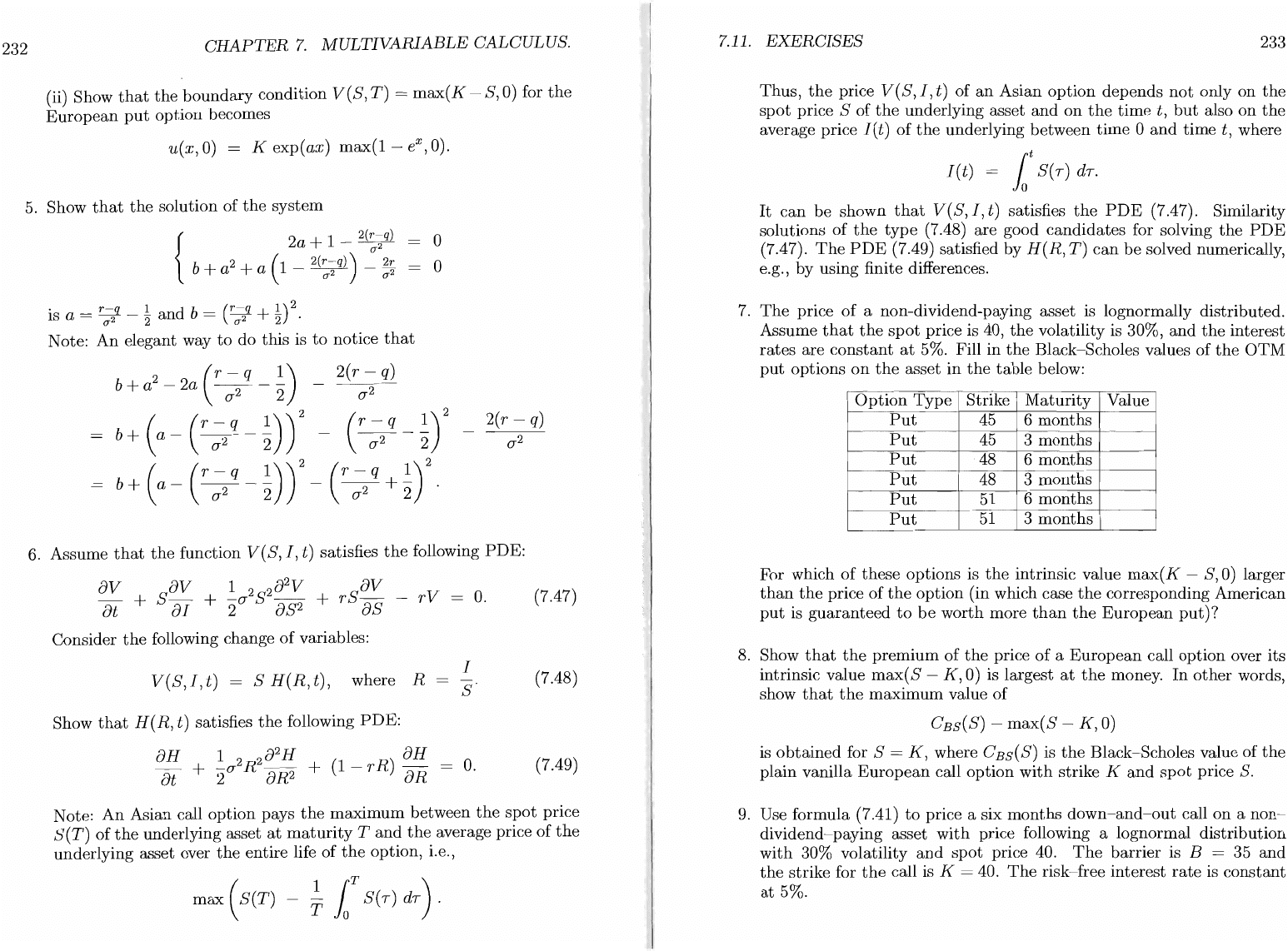
232
CHAPTER
7.
MULTIVARIABLE
CALCULUS.
(ii) Show
that
the
boundary
condition
V(S,
T)
=
max(K
- S, 0) for
the
European
put
option
becomes
u(x,O) = K exp(ax)
max(1
-
eX,
0).
5. Show
that
the
solution of
the
system
{
2a
+ 1 _
2(r-q)
b+a
2
+a
(1-
2(:~q))
-"';~
. _
r-q
1 d b _
(r-
q
1)
2
IS
a -
~
-
"2
an
- (7"2 + 2 .
Note:
An
elegant way
to
do
this
is
to
notice
that
2
(r-
q
1)
2(r-q)
b+a
-2a
----
-
(j2
2
(j2
o
o
b+(a-(r;2q-Dr
-
(r~q_D2
r-q
1
r-q
1
))
2 (
)2
b+(a-(~-2
-
~+2
2(r -
q)
(j2
6.
Assume
that
the
function
V(S,
I,
t) satisfies
the
following
PDE:
av
av
1 2 2
a2v
av
V 0
at
+ S
aI
+ 2(j S
aS
2
+ r S
as
- r = .
(7.47)
Consider
the
following change
of
variables:
V(S,
I,
t) = S
H(R,
t), where R
(7.48)
Show
that
H(R,
t) satisfies
the
following
PDE:
aH
1 2R
2a2H
(
R)
aH
0
at
+ 2(j aR2 + 1 - r
aR
= .
(7.49)
Note:
An
Asian call
option
pays
the
maximum
between
the
spot
price
S(T)
of
the
underlying asset
at
maturity
T
and
the
average price
of
the
underlying asset over
the
entire
life of
the
option, i.e.,
mme
(8(T)
-
~
[ 8(T) dT) .
7.11.
EXERCISES
233
Thus,
the
price
V(S,
I,
t) of
an
Asian
option
depends
not
only on
the
spot
price S
of
the
underlying asset
and
on
the
time
t,
but
also
on
the
average price
I(t)
of
the
underlying between
time
0
and
time
t, where
I(t) =
l'
8(T)
dT.
It
can
be
shown
that
V(S,
I,
t) satisfies
the
PDE
(7.47). Similarity
solutions
of
the
type
(7.48)
are
good
candidates
for solving
the
PDE
(7.47).
The
PDE
(7.49) satisfied by
H(R,
T)
can
be
solved numerically,
e.g.,
by
using finite differences.
7.
The
price
of
a non-dividend-paying asset is lognormally distributed.
Assume
that
the
spot
price is 40,
the
volatility is 30%,
and
the
interest
rates
are
constant
at
5%. Fill
in
the
Black-Scholes values of
the
OTM
put
options
on
the
asset
in
the
table
below:
Option
Type
Strike
Maturity
Value
Put
45 6
months
Put
45 3
months
Put
48 6
months
Put
48 3
months
Put
51
6
months
Put
51
3
months
For which
of
these
options is
the
intrinsic value
max(K
- S,O) larger
than
the
price
of
the
option
(in which case
the
corresponding American
put
is
guaranteed
to
be
worth
more
than
the
European
put)?
8.
Show
that
the
premium
of
the
price
of
a
European
call
option
over
its
intrinsic value
max(S
-
K,
0)
is largest
at
the
money.
In
other
words,
show
that
the
maximum
value
of
CBS(S) -
max(S
- K,O)
is
obtained
for S =
K,
where CBS(S) is
the
Black-Scholes value
of
the
plain
vanilla
European
call
option
with
strike K
and
spot
price S.
9.
Use formula (7.41)
to
price a six
months
down-and-out
call
on
a
non-
dividend-paying
asset
with
price following a lognormal
distribution
with
30% volatility
and
spot
price 40.
The
barrier
is B = 35
and
the
strike for
the
call is K = 40.
The
risk-free
interest
rate
is
constant
at
5%.
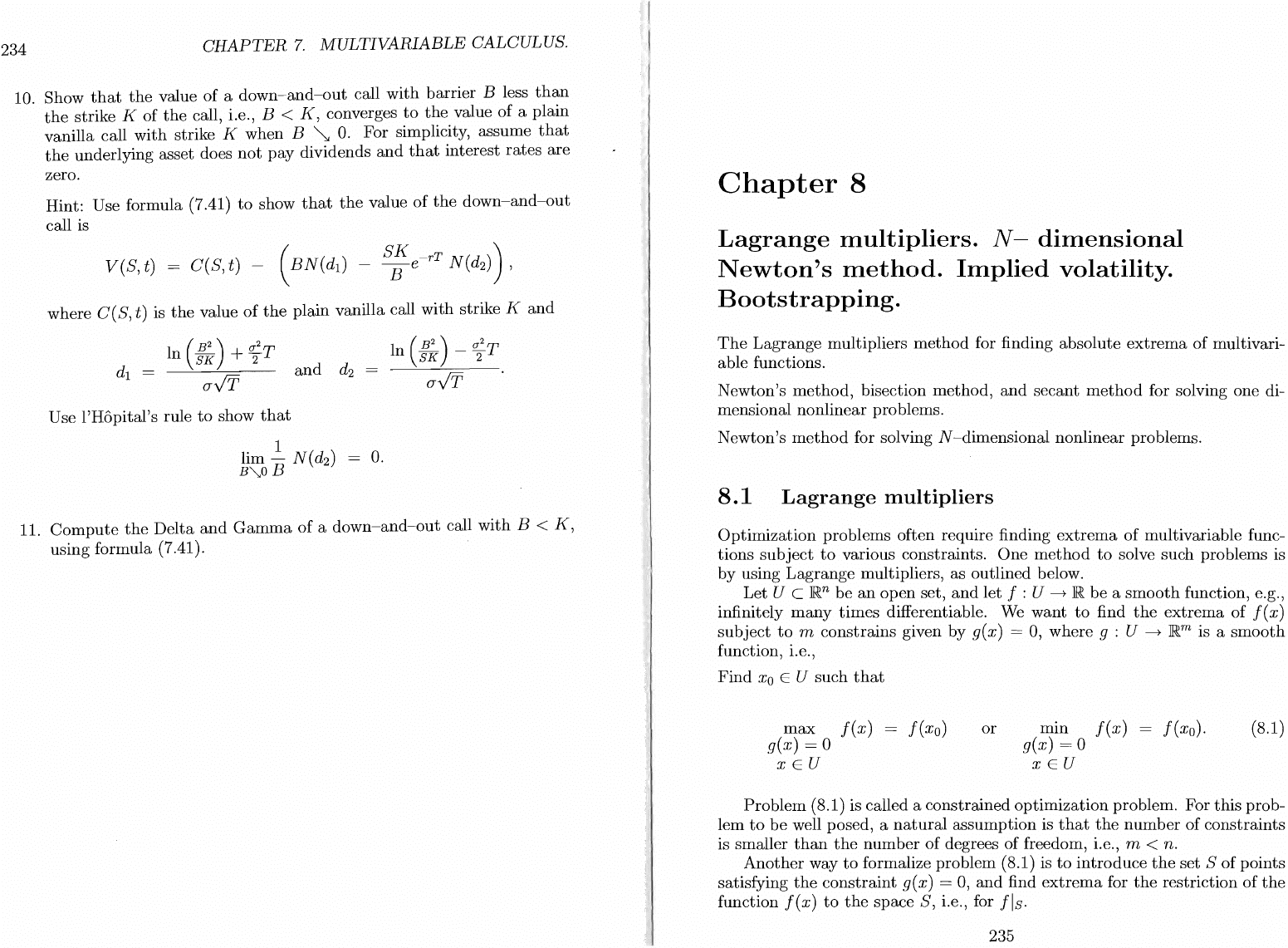
234
CHAPTER
7.
MULTIVARIABLE
CALCULUS.
10. Show
that
the
value
of
a
down-and-out
call
with
barrier
B less
than
the
strike K
of
the
call, i.e., B <
K,
converges
to
the
value
of
a
plain
vanilla call
with
strike K when B
~
O.
For simplicity, assume
that
the
underlying asset does
not
pay
dividends
and
that
interest
rates
are
zero.
Hint: Use formula (7.41)
to
show
that
the
value
of
the
down-and-out
call is
V(8, t) = C(8, t) -
(BN(d
1
) -
81~
e-
rT
N(d2)) ,
where C (S, t) is
the
value
of
the
plain
vanilla call
with
strike K
and
Use
l'Hopital's
rule
to
show
that
. 1
hm
-
N(d
2
)
B'\,oB
o.
(
B2 )
(J2T
In
SK
- 2
aVT
11.
Compute
the
Delta
and
Gamma
of
a
down-and-out
call
with
B <
K,
using formula (7.41).
Chapter
8
Lagrange
multipliers.
N-
dimensional
Newton's
method.
Implied
volatility.
Bootstrapping.
The
Lagrange multipliers
method
for finding
absolute
extrema
of
multivari-
able functions.
Newton's
method,
bisection
method,
and
secant
method
for solving one di-
mensional
nonlinear
problems.
Newton's
method
for solving
N-dimensional
nonlinear problems.
8.1
Lagrange
multipliers
Optimization
problems
often
require finding
extrema
of
multivariable func-
tions
subject
to
various constraints.
One
method
to
solve such problems is
by
using
Lagrange
multipliers, as outlined below.
Let U c
~n
be
an
open
set,
and
let
j : U
-----7
~
be
a
smooth
function, e.g.,
infinitely
many
times
differentiable. We
want
to
find
the
extrema
of
j (x)
subject
to
m
constrains
given
by
g(x) = 0, where 9 : U
-----7
~m
is a
smooth
function, i.e.,
Find
Xo
E U such
that
max
j(x)
= j(xo)
g(x) = 0
xEU
or
min
j(x)
g(x) = 0
xEU
j(xo).
(8.1)
Problem
(8.1) is called a constrained
optimization
problem. For
this
prob-
lem
to
be
well posed, a
natural
assumption
is
that
the
number
of
constraints
is smaller
than
the
number
of
degrees of freedom, i.e., m < n.
Another
way
to
formalize problem (8.1) is
to
introduce
the
set S of
points
satisfying
the
constraint
g(
x)
=
0,
and
find
extrema
for
the
restriction
of
the
function j (x)
to
the
space
S,
i.e., for j
Is.
235
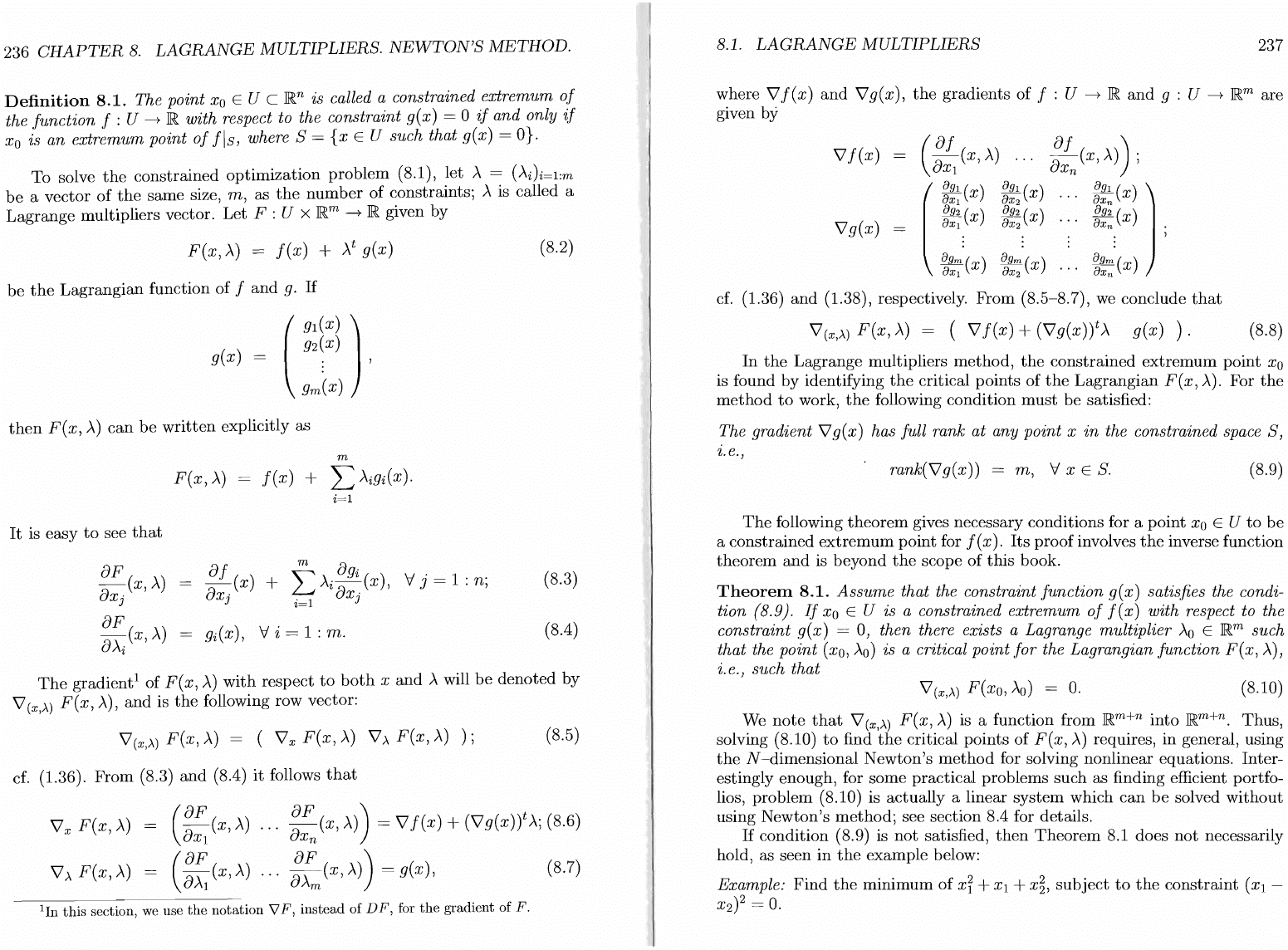
236
CHAPTER
8.
LAGRANGE
MULTIPLIERS.
NEWTON'S
METHOD.
Definition
8.1.
The point
Xo
E U c
IR
n
is called a constrained extremum
of
the function f : U
-----+
IR
with respect to the constraint
g(
x) = 0
if
and only
if
Xo
is an extremum point
of
fls,
where S =
{x
E U such that g(x) = o}.
To
solve
the
constrained
optimization
problem
(8.1), let A =
(Ai)i=l:m
be
a
vector
of
the
same
size,
m,
as
the
number
of
constraints; A is called a
Lagrange
multipliers vector.
Let
F : U x
IR
m
-----+
IR
given
by
F(x,
A)
=
f(x)
+
At
g(x)
be
the
Lagrangian
function
of
f
and
g.
If
then
F (
x,
A)
can
be
written
explicitly as
It
is
easy
to
see
that
8F
8X.(X,A)
J
8F
8Ai (x,
A)
m
F(x,
A)
=
f(x)
+ L Aigi(X).
i=l
= gi(X),
\I
i = 1 :
m.
(8.2)
(8.3)
(8.4)
The
gradient
1
of
F(x,
A)
with
respect
to
both
x
and
A will
be
denoted
by
V(X,A)
F(x,
A),
and
is
the
following row vector:
V(X,A)
F(x,
A)
= ( V x
F(x,
A)
VA
F(x,
A)
);
(8.5)
cf. (1.36).
From
(8.3)
and
(8.4)
it
follows
that
Vx
F(x,
A)
(
8F
8X1
(x,
A)
-(X,A)
=
Vf(x)
+ (Vg(X))tA;
(8.6)
8F
)
8x
n
VA
F(X,A)
(
8F
8A1
(x,
A)
-(x,
A)
= g(x),
(8.7)
8F
)
8A
m
1
In
this
section,
we
use
the
notation
V
F,
instead
of
D
F,
for
the
gradient of F.
8.1.
LAGRANGE
MULTIPLIERS
237
where
Vf(x)
and
Vg(x),
the
gradients of f : U
-----+
IR
and
9 : U
-----+
IRm
are
given by
v
f(x)
(:;,
(x,
>.)
...
::n
(x,
>.))
;
(
~;~
(x)
~;~
(x)
...
~;~
(x) )
Og2
(x)
Og2
(x) '"
Og2
(x)
Vg(x)
OXl.
OX2
. .
OXn.
;
. . . .
. .
. .
ogm
(x)
ogm
(x)
ogm
(x)
OXl
OX2
OXn
cf. (1.36)
and
(1.38), respectively. From (8.5-8.7), we conclude
that
V(X,A)
F(x,
A)
=
(Vf(x)+(Vg(x))tA
g(x)).
(8.8)
In
the
Lagrange multipliers
method,
the
constrained
extremum
point
Xo
is found
by
identifying
the
critical points
of
the
Lagrangian
F(x,
A).
For
the
method
to
work,
the
following condition
must
be
satisfied:
The gradient V
g(
x)
has full rank at any point x in the constrained space
S,
i.e.,
rank(Vg(x))
= m,
\I
XES.
(8.9)
The
following
theorem
gives necessary conditions for a
point
Xo
E U
to
be
a constrained
extremum
point
for f (
x).
Its
proof
involves
the
inverse function
theorem
and
is
beyond
the
scope of this book.
Theorem
8.1.
Assume that the constraint function g(
x)
satisfies the condi-
tion
{8.9}.
If
Xo
E U is a constrained extremum
of
f(x)
with respect to the
constraint
g(
x)
=
0,
then there exists a Lagrange multiplier
AO
E
IRm
such
that the point (xo,
AO)
is a critical point for the Lagrangian function
F(x,
A),
i.
e., such that
V(X,A)
F(xo,
AO)
=
o.
(8.10)
We
note
that
V(X,A)
F(x,
A)
is a function from
IRm+n
into
IRm+n.
Thus,
solving (8.10)
to
find
the
critical
points
of
F(x,
A)
requires,
in
general, using
the
N-dimensional
Newton's
method
for solving nonlinear equations. Inter-
estingly enough, for some practical problems such as finding efficient portfo-
lios,
problem
(8.10) is
actually
a linear
system
which
can
be
solved
without
using
Newton's
method;
see section 8.4 for details.
If
condition (8.9) is
not
satisfied,
then
Theorem
8.1 does
not
necessarily
hold, as seen
in
the
example below:
Example:
Find
the
minimum
of
XI
+
Xl
+
x§,
subject
to
the
constraint
(Xl
-
X2?
=
o.
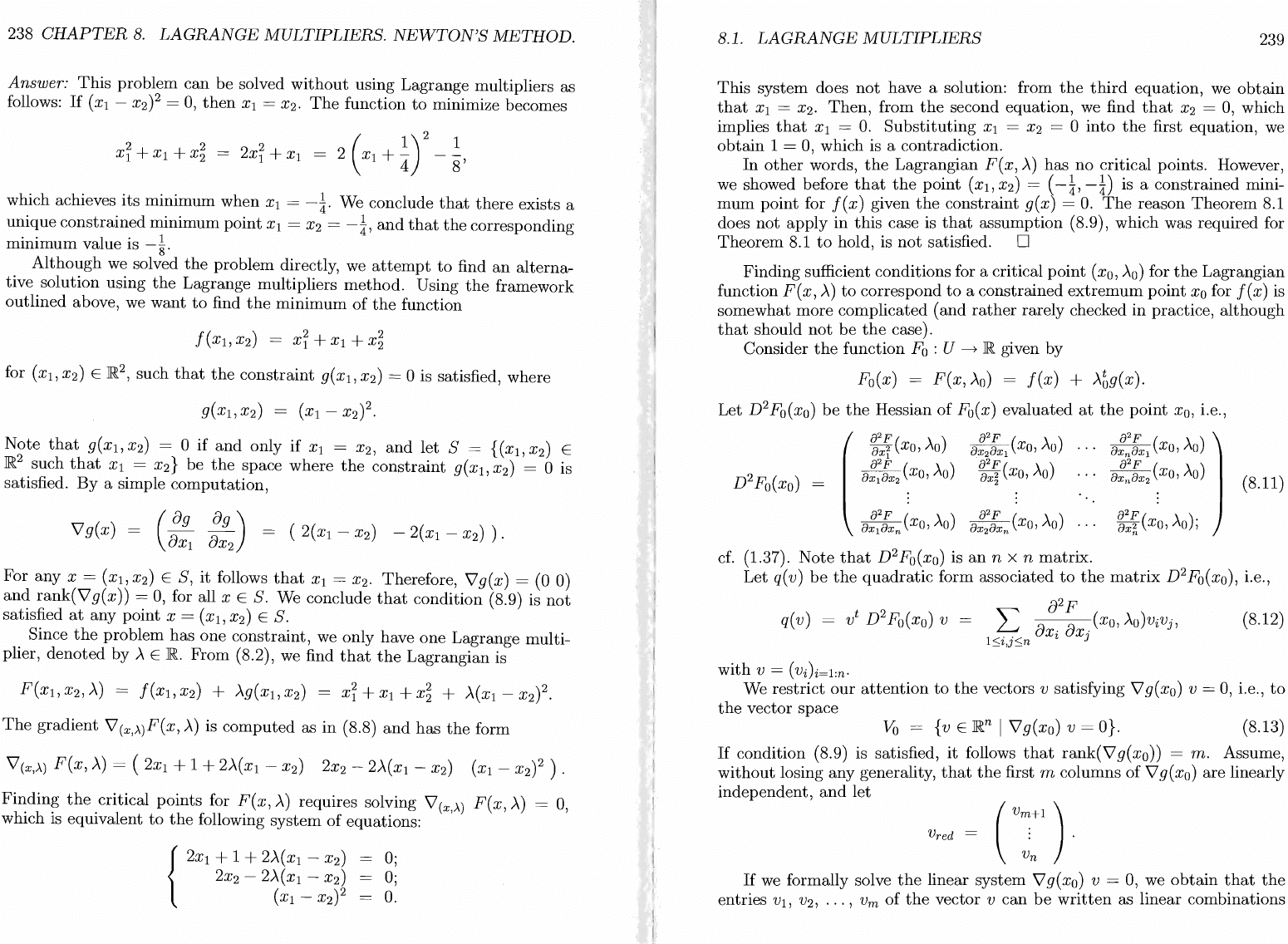
238
CHAPTER
B.
LAGRANGE
MULTIPLIERS.
NEWTON'S
METHOD.
Answer:
This
problem can
be
solved
without
using Lagrange multipliers as
follows:
If
(Xl
-
X2)2
=
0,
then
Xl
=
X2.
The
function
to
minimize becomes
which achieves
its
minimum when
Xl
=
-~.
We conclude
that
there
exists a
unique constrained minimum
point
Xl
=
X2
=
-~,
and
that
the
corresponding
minimum
value is
-~.
Although
we solved
the
problem directly, we
attempt
to
find
an
alterna-
tive solution using
the
Lagrange multipliers
method.
Using
the
framework
outlined above, we
want
to
find
the
minimum
of
the
function
f(Xl,
X2)
=
xi
+
Xl
+
x~
for (Xl,
X2)
E
JR2,
such
that
the
constraint
g(Xl,
X2)
= ° is satisfied, where
g(Xl,X2) =
(Xl
-
X2)2.
Note
that
g(Xl,
X2)
= ° if
and
only if
Xl
=
X2,
and
let
S = {(Xl,
X2)
E
JR2 such
that
Xl
=
X2}
be
the
space where
the
constraint g(Xl'
X2)
= ° is
satisfied.
By
a simple computation,
For
any
X = (Xl,
X2)
E
S,
it
follows
that
Xl
=
X2.
Therefore,
\l
g(x) = (0 0)
and
rank(\lg(x))
=
0,
for all
xES.
We conclude
that
condition (8.9) is
not
satisfied
at
any
point X = (Xl,
X2)
E S.
Since
the
problem
has
one constraint, we only have one Lagrange multi-
plier, denoted by
A E JR. From (8.2), we find
that
the
Lagrangian is
F(xl,
X2,
A)
= f(Xl,
X2)
+ Ag(Xl,
X2)
=
xi
+
Xl
+
x~
+
A(XI
-
X2)2.
The
gradient
\l(x,)..)F(x,
A)
is
computed
as
in
(8.8)
and
has
the
form
\l(x,)..)
F(x,
A)
= (
2Xl
+ 1 +
2A(XI
-
X2)
2X2
- 2A(XI -
X2)
(Xl
-
X2)2
) .
Finding
the
critical points for
F(x,
A)
requires solving
\l(x,)..)
F(x,
A)
= 0,
which is equivalent
to
the
following
system
of
equations:
B.l.
LAGRANGE
MULTIPLIERS
239
This
system does
not
have a solution: from
the
third
equation, we
obtain
that
Xl
=
X2.
Then,
from
the
second equation, we find
that
X2
= 0, which
implies
that
Xl
=
0.
Substituting
Xl
=
X2
= ° into
the
first equation, we
obtain
1 = 0, which is a contradiction.
In
other
words,
the
Lagrangian
F(x,
A)
has
no critical points. However,
we showed before
that
the
point (Xl,
X2)
=
(-~,
-~)
is a constrained mini-
mum
point
for
f(x)
given
the
constraint g(x) = 0.
The
reason
Theorem
8.1
does
not
apply
in
this
case is
that
assumption (8.9), which was required for
Theorem
8.1
to
hold, is
not
satisfied. D
Finding sufficient conditions for a critical
point
(xo,
AO)
for
the
Lagrangian
function
F ( x,
A)
to
correspond
to
a constrained
extremum
point
Xo
for f ( x) is
somewhat more complicated (and
rather
rarely checked in practice, although
that
should
not
be
the
case).
Consider
the
function
Fo
: U ----7 JR given by
Fo(x) =
F(x,
AO)
=
f(x)
+
Agg(X).
Let
D2
Fo(xo)
be
the
Hessian of Fo(x) evaluated
at
the
point
Xo,
i.e.,
(PF
)
8
2
F (
A)
8
2
F (
A)
p(XO,Ao
8X28xI
Xo,
0
8x
n
8x
I
Xo,
0
Xl
8
2
F (
A)
8
2
F ( )
8
2
F (
A)
D2
Fo(xo)
8Xl8x2
Xo,
0
8x2
XO,
AO
8x
n
8x
2
Xo,
0
(8.11)
2
8
2
F (
A)
8x
l
8x
n
Xo,
0
8
2
F ( )
~
Xo,AO
X2
x"
8
2
F(
).
8x~
xo,
AO
,
cf. (1.37). Note
that
D2
Fo(xo) is
an
n x n matrix.
Let
q(
v)
be
the
quadratic
form associated
to
the
matrix
D2
Fo(xo), i.e.,
(8.12)
with
v =
(Vi)i=l:n'
We restrict
our
attention
to
the
vectors v satisfying
\l
g(xo) v =
0,
i.e.,
to
the
vector space
Va
= {v E
JRn
I \lg(xo) v =
O}.
(8.13)
If
condition (8.9) is satisfied,
it
follows
that
rank(\l
g(xo)) = m. Assume,
without
losing
any
generality,
that
the
first m columns of
\l
g(xo) are linearly
independent,
and
let
If
we formally solve
the
linear system
\l
g(xo) v = 0, we
obtain
that
the
entries
VI,
V2,
...
,
Vm
of
the
vector v can
be
written
as linear combinations
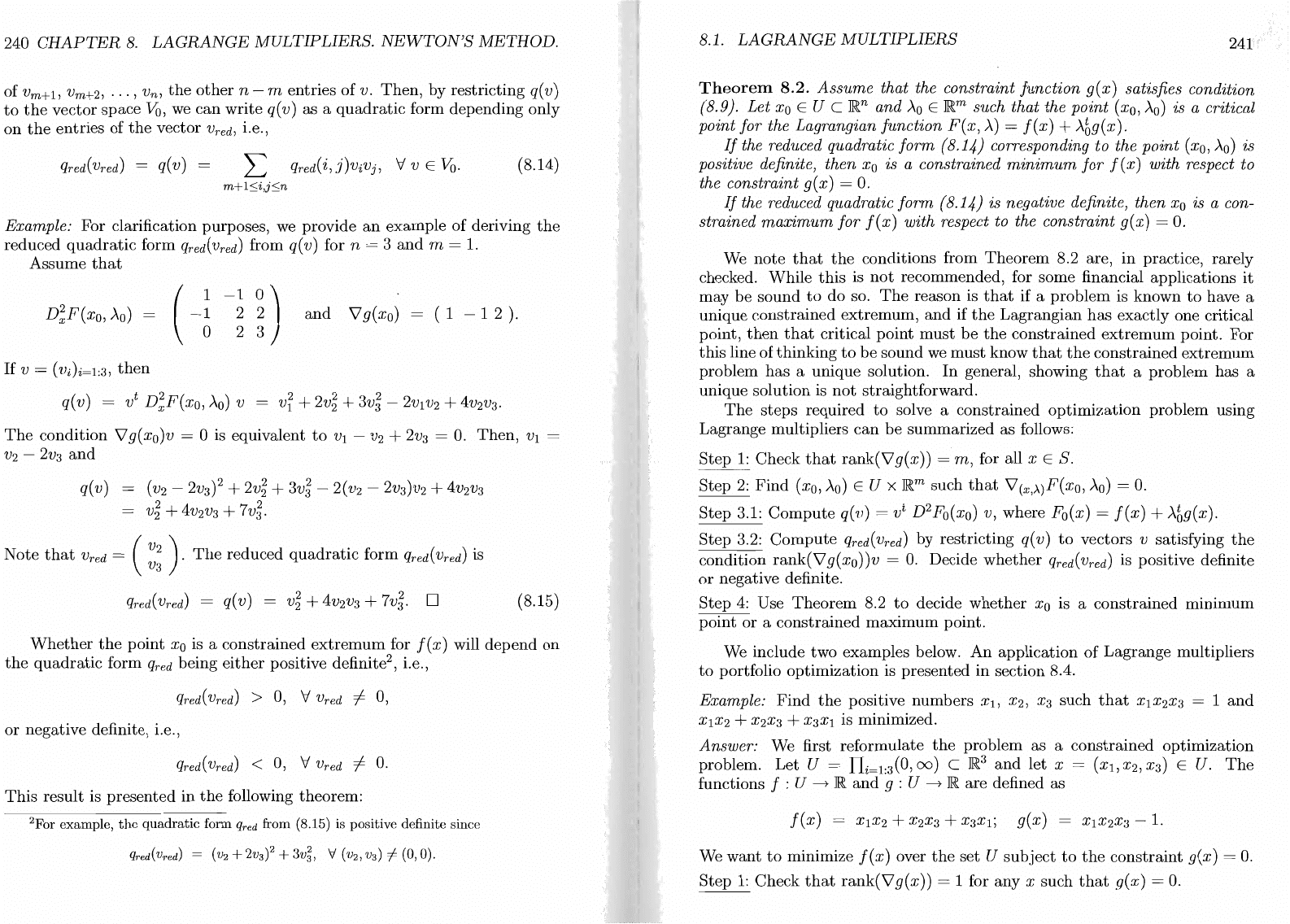
240
CHAPTER
8.
LAGRANGE
MULTIPLIERS.
NEWTON'S
METHOD.
of
Vm+l,
V
m
+2,
...
, V
n
,
the
other
n - m
entries
of
v.
Then,
by
restricting
q(v)
to
the
vector
space
Va,
we
can
write
q(
v)
as a
quadratic
form
depending
only
on
the
entries
of
the
vector
Vred,
i.e.,
L qred(i,j)vivj, \;j v E
Va.
m+ls:i,js:n
(8.14)
Example:
For
clarification
purposes,
we
provide
an
example
of
deriving
the
reduced
quadratic
form
qred(
Vred)
from q( v) for n = 3
and
m = 1.
Assume
that
(
-~ -~
n and
~g(xo)
(1
- 1 2 ).
If
v = (Vi)i=I:3,
then
q(v) = v
t
D;F(xo,
Ao)
v =
v;
+
2v~
+
3v~
-
2VIV2
+
4V2V3.
The
condition
\l
g(xo)v = ° is equivalent
to
VI
-
V2
+
2V3
= 0.
Then,
VI
=
V2
-
2V3
and
q(
v) =
(V2
- 2V3? +
2v~
+
3v~
-
2(
V2
-
2V3)V2
+
4V2V3
=
v~
+
4V2V3
+
7v~.
Note
that
Vred = (
~~
).
The
reduced
quadratic
form
qred(V"d)
is
qred(
Vred)
=
q(
v) =
v~
+
4V2V3
+
7v~.
0
(8.15)
Whether
the
point
Xo
is a
constrained
extremum
for f ( x) will
depend
on
the
quadratic
form
qred
being
either
positive
definite
2
,
i.e.,
or
negative
definite, i.e.,
qred(
Vred)
< 0, \;j
Vred
# 0.
This
result
is
presented
in
the
following
theorem:
example,
the
quadratic
form
qred
from (8.15) is positive definite since
8.1.
LAGRANGE
MULTIPLIERS
241
Theorem
8.2.
Assume
that the constraint function g(x) satisfies condition
( 8.
g).
Let
Xo
E U C
ffi.n
and
Ao
E
ffi.m
such that the point (xo,
Ao)
is a critical
point for the Lagrangian function
F(x,
A)
=
f(x)
+ Ab9(x).
If
the reduced quadratic form (8.14) corresponding to the point (xo,
Ao)
is
positive definite, then
Xo
is
a constrained
minimum
for f (x) with respect to
the constraint g( x)
=
O.
If
the reduced quadratic form (8.14) is negative definite, then
Xo
is a con-
strained
maximum
for
f(x)
with respect to the constraint g(x) = 0.
We
note
that
the
conditions
from
Theorem
8.2 are,
in
practice,
rarely
checked.
While
this
is
not
recommended,
for
some
financial
applications
it
may
be
sound
to
do
so.
The
reason
is
that
if
a
problem
is
known
to
have a
unique
constrained
extremum,
and
if
the
Lagrangian
has
exactly
one
critical
point,
then
that
critical
point
must
be
the
constrained
extremum
point.
For
this
line
of
thinking
to
be
sound
we
must
know
that
the
constrained
extremum
problem
has
a
unique
solution.
In
general, showing
that
a
problem
has
a
unique
solution
is
not
straightforward.
The
steps
required
to
solve a
constrained
optimization
problem
using
Lagrange
multipliers
can
be
summarized
as
follows:
Step
1:
Check
that
rank(\lg(x))
=
m,
for all
xES.
Step
2:
Find
(xo,
Ao)
E U X
ffi.m
such
that
\l(x,)..)F(xo,
Ao)
= 0.
Step
3.1:
Compute
q(v) = v
t
D2
Fo(xo) v,
where
Fo(x) =
f(x)
+ Ab9(x).
Step
3.2:
Compute
qred(
Vred)
by
restricting
q(
v)
to
vectors
v satisfying
the
condition
rank(\l
g(xo))v = 0. Decide
whether
qred(
Vred)
is positive definite
or
negative
definite.
Step
4:
Use
Theorem
8.2
to
decide
whether
Xo
is a
constrained
minimum
point
or
a
constrained
maximum
point.
We
include
two
examples
below.
An
application
of
Lagrange
multipliers
to
portfolio
optimization
is
presented
in
section
8.4.
Example:
Find
the
positive
numbers
xl,
X2,
X3
such
that
XIX2X3
= 1
and
XIX2
+
X2X3
+
X3XI
is minimized.
Answer:
We
first
reformulate
the
problem
as
a
constrained
optimization
problem.
Let
U =
I1i=I:3(0,oo)
C
ffi.3
and
let
x = (XI,X2,X3) E U.
The
functions f : U ----7
ffi.
and
9 : U ----7
ffi.
are
defined as
f(x)
We
want
to
minimize
f(x)
over
the
set
U
subject
to
the
constraint
g(x) = 0.
Step
1:
Check
that
rank(\lg(x))
= 1 for
any
x
such
that
g(x) = 0.
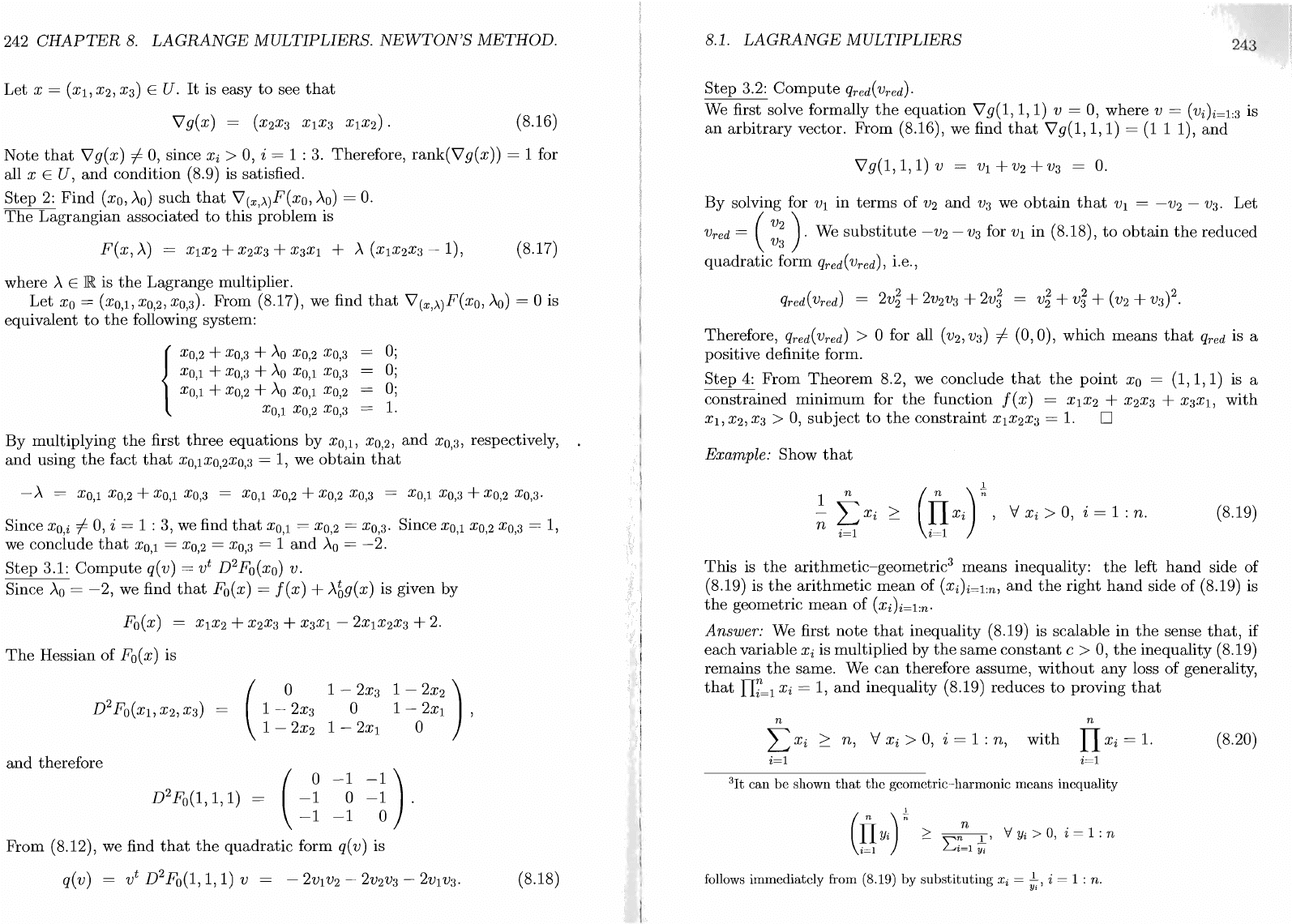
242
CHAPTER
8.
LAGRANGE
MULTIPLIERS.
NEWTON'S
METHOD.
Let
x =
(Xl,
X2,
X3)
E
u.
It
is easy
to
see
that
Vg(x)
=
(X2X3
XIX3
XIX2).
(8.16)
Note
that
\lg(x)
i- 0, since
Xi
> 0, i = 1 : 3. Therefore,
rank(Vg(x))
= 1 for
all
x E U,
and
condition (8.9) is satisfied.
Step
2:
Find
(xo,
Ao)
such
that
V(x,>.)F(xo,
Ao)
= 0.
The
Lagrangian
associated
to
this
problem is
F(x,
A)
=
XIX2
+
X2X3
+
X3Xl
+ A
(XIX2X3
- 1),
where A E
lR
is
the
Lagrange multiplier.
(8.17)
Let
Xo
=
(XO,1,XO,2,XO,3).
From (8.17), we find
that
V(x,>.)F(xo,Ao)
= ° is
equivalent
to
the
following system:
{
XO,2
+
XO,3
+
Ao
XO,2
XO,3
=
0;
XO,l +
XO,3
+
Ao
XO,l XO,3 =
0;
XO,l +
XO,2
+
Ao
XO,l XO,2 = 0;
XO,l
XO,2
XO,3 =
1.
By
multiplying
the
first
three
equations by
XO,l,
XO,2,
and
XO,3, respectively,
and
using
the
fact
that
XO,lXO,2XO,3 =
1,
we
obtain
that
- A = XO,l
XO,2
+ XO,l
XO,3
= XO,l
XO,2
+
XO,2
XO,3
= XO,l
XO,3
+
XO,2
XO,3·
Since
Xo
i i- 0, i = 1 : 3, we find
that
Xo
1 =
X02
=
X03·
Since
Xo
1
X02
x03
we conclude
that
XO,l =
XO,2
=
XO,3
= i
and
~o
= -2.
",
1,
Step
3.1:
Compute
q(v)
= v
t
D
2
F
o
(xo)
v.
Since
Ao
=
-2,
we find
that
Fo(x)
=
f(x)
+
Abg(x)
is given by
Fo(x)
=
XIX2
+
X2X3
+
X3Xl
-
2XIX2X3
+
2.
The
Hessian of F
o
(x)
is
and
therefore
D2
F
o
(1, 1, 1) =
(-
~
-
~
= i ) .
-1 -1
°
From
(8.12), we find
that
the
quadratic
form
q(v)
is
(8.18)
8.1.
LAGRANGE
MULTIPLIERS
243
Step
3.2:
Compute
qred(
Vred).
We first solve formally
the
equation
Vg(l,
1,
1) v = 0, where v =
(Vi)i=1:3
is
an
arbitrary
vector. From (8.16), we find
that
Vg(l,
1,
1) =
(111),
and
v g (1,
1,
1) v =
VI
+ V2 + V3 =
0.
By
solving for
VI
in
terms
of V2
and
V3 we
obtain
that
VI
=
-V2
-
V3.
Let
Vred
= (
~~
).
We
substitute
-V2
- V3 for
VI
in
(8.18),
to
obtain
the
reduced
quadratic
form
qred(
Vred),
i.e.,
Therefore,
qred(Vred)
> ° for all
(V2'
V3)
i- (0,0), which means
that
qred
is a
positive definite form.
Step
4:
From
Theorem
8.2, we conclude
that
the
point
Xo
=
(1,1,1)
is a
constrained
minimum
for
the
function
f(x)
=
XIX2
+
X2X3
+
X3Xl,
with
Xl,
X2,
X3 > 0,
subject
to
the
constraint
XIX2X3
=
1.
D
Example: Show
that
1 n
(n)~
;,
8
Xi
~
g
Xi
,V
Xi
> 0, i = 1 : n.
(8.19)
This
is
the
arithmetic-geometric
3
means inequality:
the
left
hand
side of
(8.19) is
the
arithmetic
mean
of
(Xi)i=l:n,
and
the
right
hand
side of (8.19) is
the
geometric
mean
of
(Xi)i=l:n.
Answer: We first
note
that
inequality (8.19) is scalable
in
the
sense
that,
if
each variable
Xi
is multiplied by
the
same
constant
c > 0,
the
inequality (8.19)
remains
the
same. We
can
therefore assume,
without
any
loss of generality,
that
I1~=1
Xi
=
1,
and
inequality (8.19) reduces
to
proving
that
n
L
Xi
~
n,
V
Xi
>
0,
i = 1 : n,
i=l
n
with
II
Xi
=
1.
i=l
3It
can
be
shown
that
the
geometric-harmonic means inequality
1
(
IT
Yi)
n
;::::
,"",nn
1-'
V
Yi
>
0,
i = 1 : n
i=l
u~=l
Yi
follows immediately from (8.19)
by
substituting
Xi
=
t,
i = 1 : n.
(8.20)
